
- X (Twitter)

The Benefits of Mind Mapping for Writing (And How You Can Get Started Right Away)
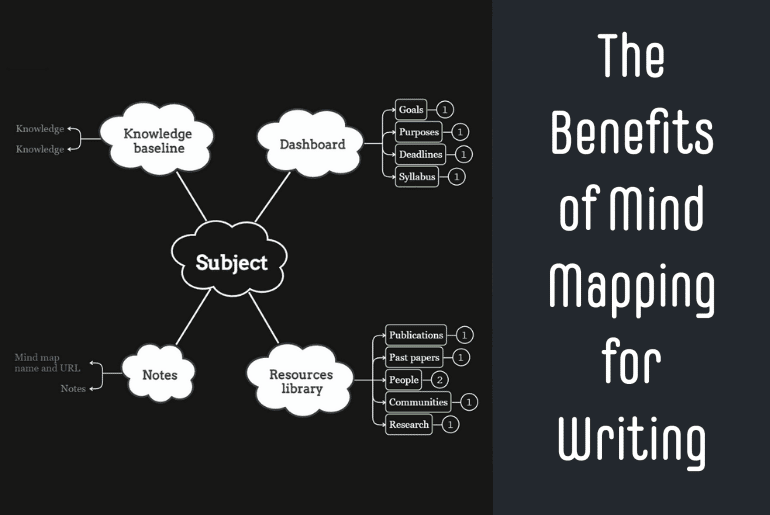
Crafting a bestselling novel isn’t for the faint of heart. And not just because of all the writing, editing, and marketing. Trying to keep all those plot points, characters, settings, and other details straight can be a major challenge. And the further in you get, the more difficult it becomes.
Fortunately, there is a way to streamline your writing process and reign in the complexity of your story’s world. Mind mapping for writing can help you get organized, stay focused, and write faster. And that means you’ll reach the finish line of your story sooner.
But mind maps aren’t just for writing fiction. They can be used for all types of writing. And you don’t even need a stash of pen and paper. With mind mapping software at your side, you’ll be able to write better blog posts, research papers, and more .
Keep reading to discover how a mind mapping tool could be just the jumpstart your writing process has been needing.
What is mind mapping anyway?
Mind mapping is a technique that can be used to brainstorm ideas, organize your thoughts , or remember something more easily. The basic idea is to create a map of your thoughts by connecting related ideas with lines and arrows. This can help you to see the connections between different ideas and to remember information more effectively.
Mind maps come in a variety of styles, from timeline mind maps to Venn diagrams . And each kind of graphic organizer offers unique benefits.
How can mapping be useful in writing fiction?
As any novelist knows, writing a book is no easy feat. You don’t just have to come up with a compelling story. You’ve also got to keep track of all the different characters and plot threads.
Mind mapping can be a helpful tool for keeping everything organized. By creating a mind map, you can visualize the different elements of your story.
For example, you might brainstorm story ideas for a single book or an entire series. Then, you could create a timeline mind map to give yourself a clear picture of when events take place. You could even include significant events that happened before or after your story. Mind maps can also help you flesh out your characters. They offer a place to describe them physically, psychologically, and in other ways.
And with mind mapping software , you can even add images and links to show relationships to other characters or places.
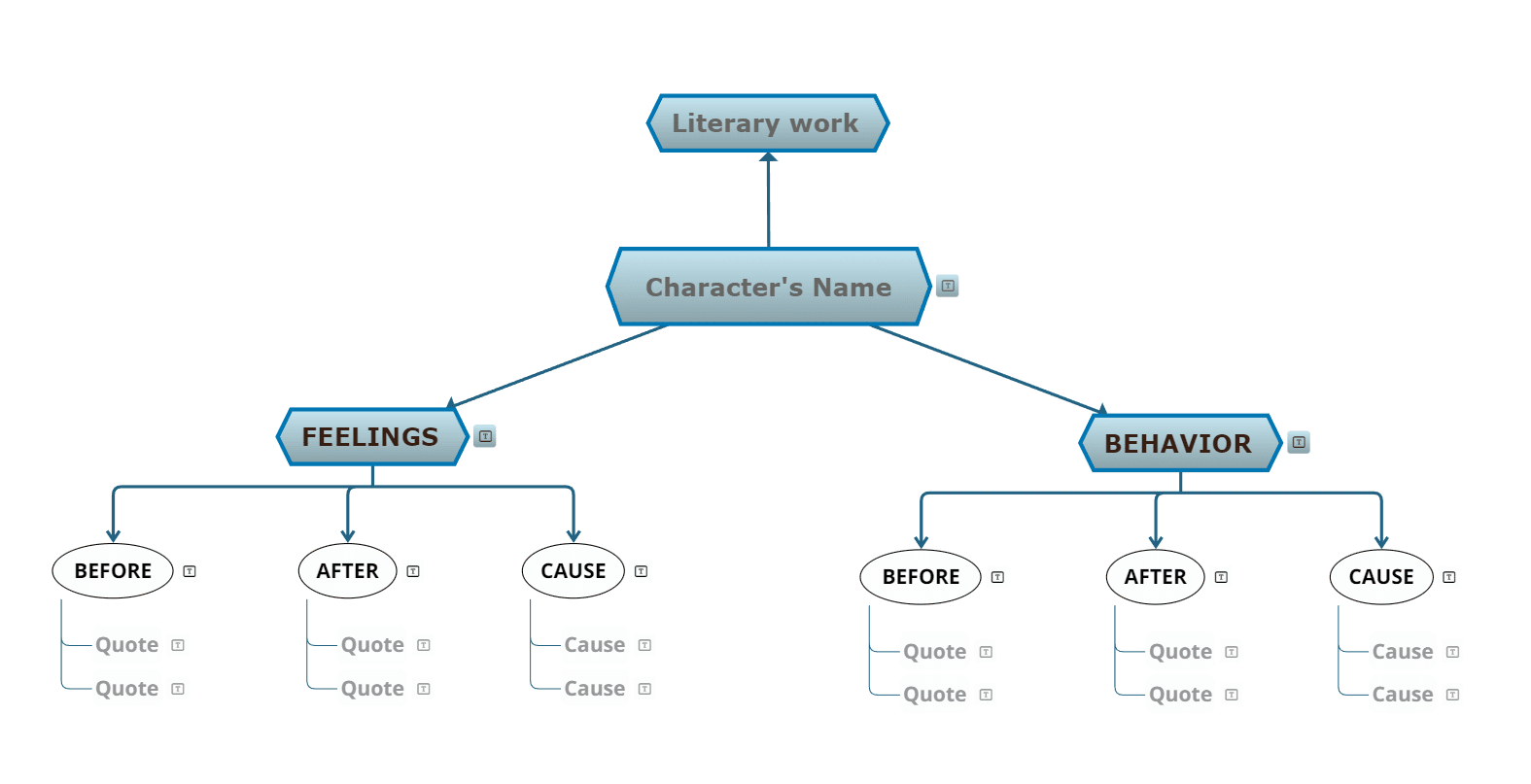
How do you create a mind map for a story?
Want to know specifically how to mind map for fiction?
First, you’ll need to think through the kinds of mind maps you’ll need. Will character maps be beneficial? Could you use mind maps describing particular scenes or settings? Would a timeline be helpful? How about a mind map that divides your story into its various beats?
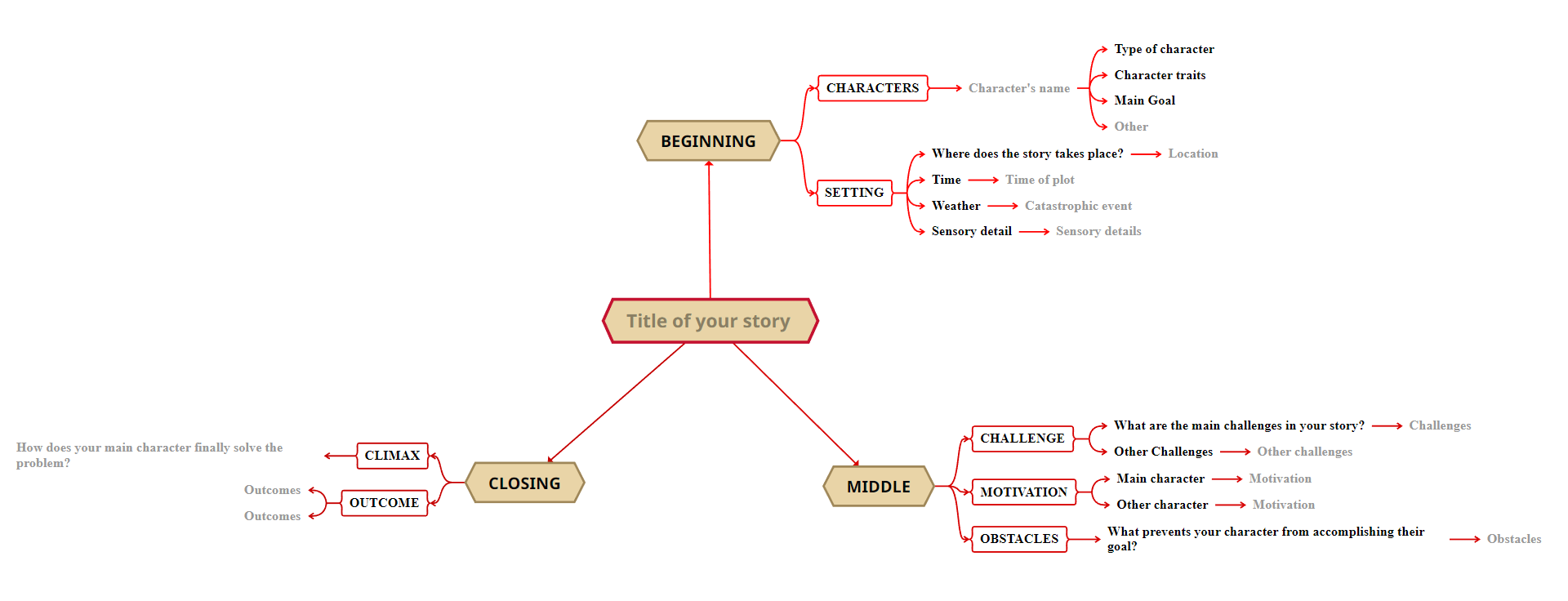
Once you’ve decided which mind maps will be best for your story, choose mind map templates that fit your need. Mindomo has a host of templates specifically for literature and writing. There, you’ll find everything from characterization study maps to story maps and more.
Once you’ve finished your mind maps, they can be used as a guide when writing the actual story. They’ll make it easy to ensure all of the important elements are included.

But a mind mapping tool won’t just help you keep each individual story straight. You can also use them to track your progress, setting yourself milestones for each section of the book. And if you ever get stuck, mind maps can provide a handy way to jump-start your creative juices. After all, they’re the perfect tool for brainstorming.
How can mind mapping be useful in other types of writing?
Maybe you’re not a fiction writer. That doesn’t mean mind mapping isn’t for you. Mind mapping benefits extend to any type of writing.
Start by brainstorming your ideas and then organize them into categories. Once you have the structure of your post, use your mind map to identify your central topic. You can also use the mind map to come up with good ideas for supporting points. Then, you can add them as child branches on your map.
With a clear outline of your post or article, it will be much easier to write the actual content. And if there’s something you’d like to add or change while writing, simply update your mind map accordingly.
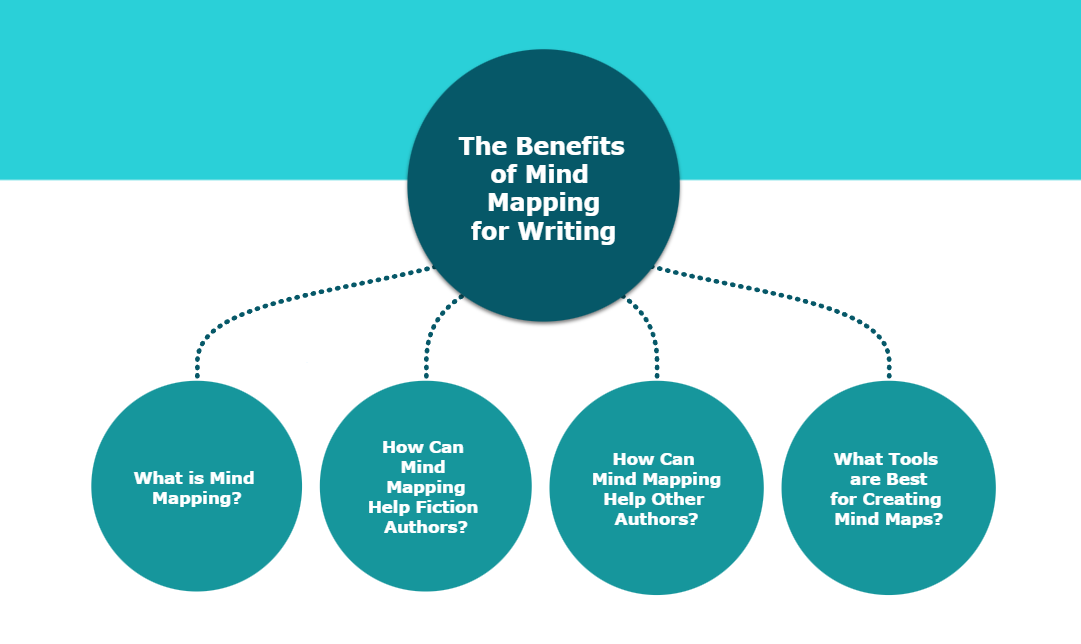
For maximum efficiency, you can also use a digital mind map for outlining and organizing the flow of the post. And you may even be able to create a mind map to illustrate your central topic or a supporting idea. Having all these elements at your fingertips will ensure that your blog posts are well thought out and organized. You can use mind mapping to structure an essay with ease.
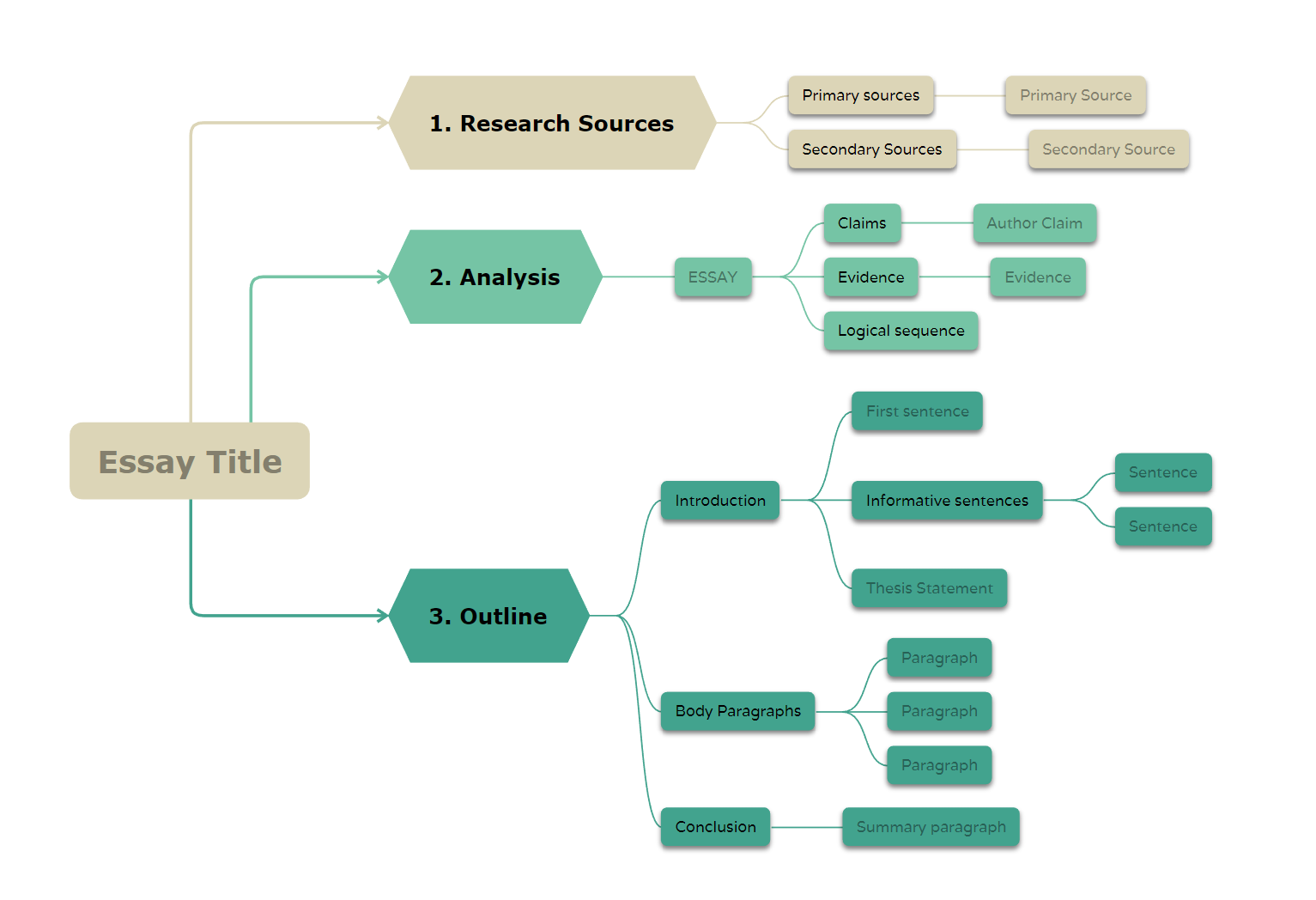
With a mind map, you’ll save yourself from wasting valuable time and energy on unnecessary rewrites. Having a clear plan in place before starting your writing makes it much easier to stay organized. That way, you can produce better content faster.
Use mind maps to structure your paragraphs:
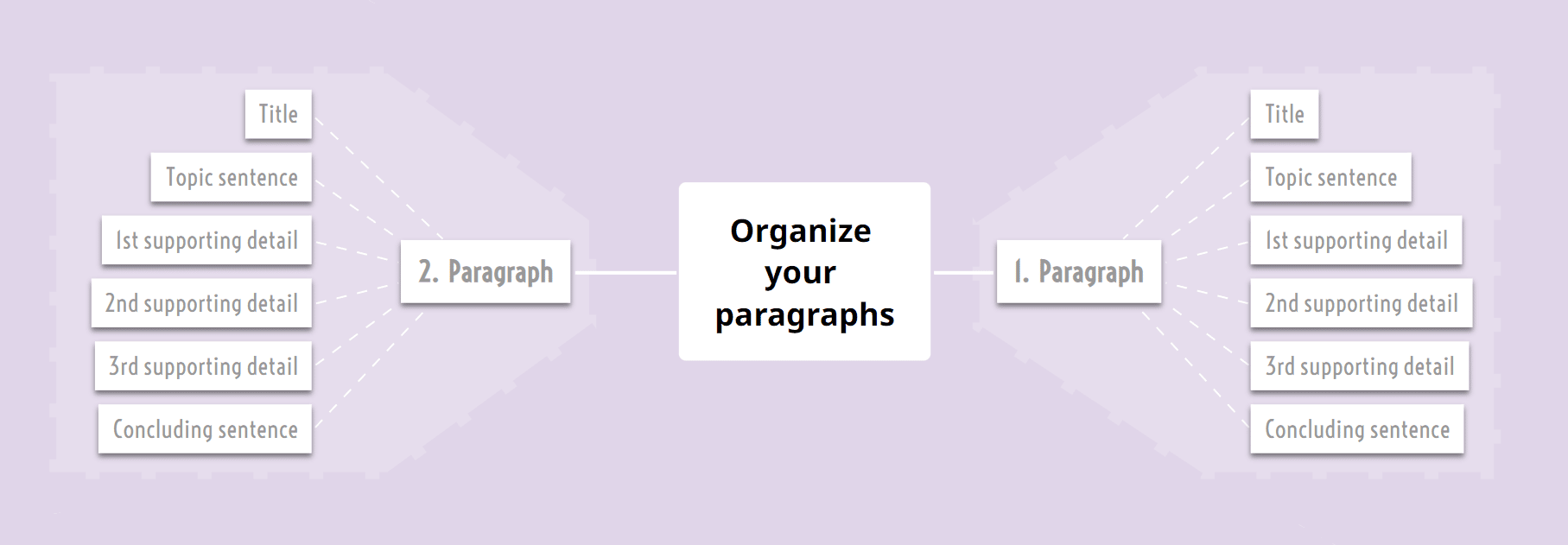
Use mind mapping software like Mindomo to create mind maps
While mind mapping may sound like a complicated process, it can actually be quite simple. All you need is a piece of paper and a pen, and you can get started. However, pen and paper will only take you so far. If you really want to take full advantage of creating a mind map, you’ll need mind mapping software.
Mind mapping software like Mindomo makes it easy to create mind maps. You can start with a blank canvas or use one of the many mind map templates available. The software provides a variety of tools for adding text, images, links, and other information to your mind map. You can also customize the appearance of your mind map, including the color scheme, shape, font, size, and lines. Best of all, mind mapping is a fun and effective way to learn and remember information.
No matter what you’re looking to write, Mindomo has mind map examples and templates you can use to get started. Simply choose a template that fits your needs, add your own central topic, and edit it to your heart’s content.
That’s everything you need to know about creating a mind map for your next project. From brainstorming ideas to tracking progress and getting organized, mind mapping can be a valuable tool for any type of writer. With the help of mind mapping software like Mindomo, you’ll be able to take your writing to the next level.
So, what are you waiting for? Start mind mapping today and see how it can help you produce better stories, articles, and papers than ever before.
Keep it smart, simple, and creative! The Mindomo Team
Related Posts

Unlocking the Power of Mind Mapping Software for Students

Unlocking the Power of Biology Mind Maps: A Visual Learning Revolution

Improving English Fluency: The Role of Mind Maps for English Learning
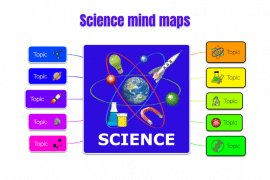
Science Mind Maps: Harnessing the Power of Mind Maps for Science Research
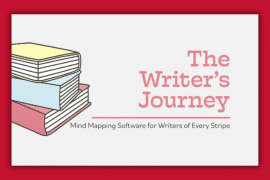
The Writer’s Journey: Mind Mapping Software for Writers of Every Stripe

Cracking the Code to Creative Thinking: Ignite Your Brain and Unleash Your Ideas
Write a comment cancel reply.
Save my name, email, and website in this browser for the next time I comment.
The Mind Mapping Guide for Creative Writers
Introduction.
Welcome to “The Mind Mapping Guide for Creative Writers”! In this guide, we will explore the powerful technique of mind mapping and how it can enhance the creative writing process.
Mind mapping is a visual tool that helps organize thoughts, concepts, and ideas in a non-linear and creative way. It allows writers to tap into their imagination, generate new ideas, and create a structure for their writing projects.
Creativity plays a crucial role in writing, as it helps writers think outside the box, explore new perspectives, and engage readers. By utilizing mind mapping techniques, writers can unlock their creativity and unleash their full potential.
The purpose of this guide is to provide writers with a comprehensive understanding of mind mapping and its applications in the writing process. From generating ideas to organizing thoughts and creating characters and plots, we will cover various aspects of mind mapping that can greatly benefit writers.
Whether you are a seasoned writer or just starting out, this guide will provide you with valuable insights and practical techniques for incorporating mind mapping into your creative writing practice.
So, let’s dive in and discover the limitless possibilities that mind mapping offers to creative writers!
Benefits of Mind Mapping for Writers
Mind mapping is a powerful technique that can offer numerous benefits to writers. By visually organizing thoughts and ideas, writers can enhance their creativity, improve their productivity, and create structure in their writing projects. Here are some key benefits of using mind mapping for writers:
Enhancing Creativity and Generating New Ideas
Mind mapping encourages free thinking and allows writers to explore new ideas and connections. By starting with a central topic or theme and adding related ideas and associations, writers can generate a wealth of creative possibilities. The non-linear structure of mind maps allows for the exploration of multiple paths, leading to unique and innovative ideas that may have otherwise remained hidden. This creativity boost can help writers overcome writer’s block and inject freshness into their writing.
Organizing Thoughts and Creating Structure
One of the biggest challenges for writers is organizing their thoughts and creating a coherent structure for their writing. Mind mapping provides a visual way to organize ideas, helping writers see the relationships between different concepts and ensuring a logical flow in their writing. Writers can create hierarchies, add connections, and group related ideas, enabling them to create a clear and well-structured outline for their work. This organizational framework not only saves time but also makes the writing process more efficient.
Increasing Productivity and Efficiency
By using mind maps, writers can streamline their writing process and increase their productivity. Instead of getting overwhelmed by a blank page or a jumble of ideas, mind mapping allows writers to break their tasks into smaller, manageable chunks. Writers can focus on individual topics or ideas, leading to increased focus and better time management. The visual nature of mind maps also aids in quick information retrieval, allowing writers to access relevant details without digging through pages of notes. This efficiency boost can help writers meet deadlines and overcome procrastination.
Improving Memory and Retention
The combination of visual and verbal elements in mind maps enhances memory and retention for writers. Research has shown that visual representations aid in information processing and help in retaining information for a longer period. By mapping their ideas visually, writers can imprint the information more effectively in their minds, making it easier to recall while writing. Additionally, the use of keywords and concise phrases in mind maps serves as memory triggers, helping writers remember important points and supporting details. This improved memory and retention can lead to better writing quality and richer content.
In conclusion, mind mapping offers numerous benefits for writers. By enhancing creativity, organizing thoughts, increasing productivity, and improving memory, writers can harness the full potential of their ideas and produce high-quality writing. Incorporating mind mapping into their writing practice can help writers overcome challenges, unlock new perspectives, and ultimately elevate their writing to the next level.
Getting Started with Mind Mapping
To begin using mind mapping as a creative writing tool, it is essential to understand the basic concept and principles behind this technique. Mind mapping is a visual thinking tool that allows you to capture and organize your thoughts in a way that stimulates creativity and enhances your writing process.
Understanding the Basic Concept of Mind Mapping
At its core, mind mapping involves creating a visual representation of your thoughts and ideas. It starts with a central topic or theme, which is placed at the center of the mind map. From there, you can branch out and add subtopics and related ideas, creating a network of interconnected nodes.
Choosing the Right Tools and Resources
To get started with mind mapping, you need to choose the right tools and resources that suit your needs. While traditional pen and paper can work well, there are also a variety of digital mind mapping software available. Some popular options include:
MindMeister : This web-based mind mapping tool allows you to create, collaborate, and share mind maps online. It offers a range of features such as templates, the ability to attach files, and project management integration.
XMind : XMind is a powerful, open-source mind mapping software that offers a variety of features, including the ability to export mind maps in different formats, such as PDF and Word.
iThoughts : iThoughts is a mind mapping app available for iOS, macOS, and Windows. It offers a user-friendly interface and various features like exporting to other file formats and syncing across devices.
Setting Up the Mind Mapping Environment
Once you have chosen your preferred tools, it’s time to set up your mind mapping environment. Find a quiet and comfortable space to work in, where you can focus and let your creative juices flow. Make sure you have all the necessary materials, whether it be paper and markers or your preferred digital device.
Before you start mind mapping, take a moment to clear your mind and relax. This will help you to fully engage in the creative process. You might consider incorporating some breathing exercises or mindfulness techniques to help you get into the right mindset.
Now that you have an understanding of the basic concept of mind mapping and have chosen the right tools and set up your environment, you are ready to dive into the exciting world of mind mapping for creative writing. This powerful technique will help you generate new ideas, organize your thoughts, and unleash your creativity to its fullest potential.
Mind Mapping Techniques for Generating Ideas
Brainstorming and free association.
Brainstorming is a popular technique used to generate ideas. It involves the spontaneous and rapid generation of ideas without judgment or criticism. In mind mapping, you can create a central idea and branch out to different related ideas. Allow your thoughts to flow freely and write down anything that comes to mind. Don’t worry about the quality or feasibility of the ideas at this stage. Remember, the goal is to generate as many ideas as possible.
Free association is another technique that can help spark creativity. It involves making connections between unrelated ideas or words. Start with a central concept and let your mind make associations. Write down any related ideas or words that come to mind, even if they seem unrelated at first. By exploring these connections, you may stumble upon unique and innovative ideas for your writing project.
Word Webs and Concept Maps
Word webs, also known as mind webs or semantic maps, are visual representations of interconnected words or concepts. They can help you explore the relationships between different ideas and generate new connections. Start with a central word, which can be the main theme or concept you want to focus on. Then, brainstorm related words or ideas and connect them to the central word using lines or arrows. This technique can help you identify subtopics and explore different angles for your writing.
Concept maps are similar to word webs but are more structured and hierarchically organized. They use nodes and connecting lines to represent concepts and the relationships between them. Start with a central concept and add subtopics or related ideas as branches. You can further expand each branch to create a detailed map of your ideas. Concept maps are especially useful for visual learners and can provide a clear overview of the different elements of your writing project.
Using Images and Visual Stimuli
Visual stimuli can be a powerful tool for generating ideas and inspiring creativity. Using images, photographs, or visual symbols can help you tap into your imagination and explore different perspectives. You can incorporate visuals into your mind map by adding images or sketches directly to the branches or nodes. Alternatively, you can create a separate section in your mind map dedicated to visual inspiration. This technique can help you think beyond words and stimulate your visual thinking skills.
Connecting Unrelated Concepts
One of the advantages of mind mapping is its ability to encourage creative thinking by connecting seemingly unrelated concepts. By exploring different connections and associations, you can discover unique ideas and perspectives. Start by listing unrelated concepts or ideas on different nodes of your mind map. Then, look for possible connections or relationships between them. This technique can lead to unexpected and inventive ideas for your writing project.
Remember, mind mapping is a flexible technique, and you can adapt it to suit your individual style and preferences. Feel free to combine different techniques or experiment with new ones. The key is to keep an open mind and embrace your creativity. So, grab your favorite mind mapping tool and start generating innovative ideas for your writing project!
Organizing thoughts and creating structure is a crucial step in the writing process. It helps writers maintain focus, ensure logical flow, and create a coherent piece of writing. Mind mapping can be a valuable tool to help writers achieve this goal. Here are some techniques and strategies to effectively organize thoughts and create structure using mind maps:
Creating a Central Topic or Theme
Start by identifying the main topic or theme of your writing project. This could be a broad idea or a specific concept that you want to explore. In your mind map, place this central topic in the middle of the page or screen.
Adding Subtopics and Related Ideas
Next, brainstorm and identify subtopics or related ideas that are connected to the central topic. These subtopics can serve as the main sections or chapters of your writing piece. Add branches or nodes to your mind map to represent these subtopics and connect them to the central topic.
Using Color-Coding and Symbols for Categorization
To further organize your thoughts, consider using color-coding or symbols to categorize different ideas or subtopics. Assign specific colors to different categories or themes within your writing project. This visual distinction can help you easily see the connections between related ideas and maintain a clear structure in your mind map.
Connecting Nodes and Creating Flow
Connect the nodes and branches in your mind map to create a flow between ideas. Use arrows or lines to show the relationships between different concepts and subtopics. This will help you visualize the logical progression of your writing piece and ensure a smooth transition between ideas.
Reviewing and Revisiting Mind Maps Regularly
As you progress in your writing project, regularly review and revisit your mind maps. This will help you stay organized and ensure that you haven’t missed any important ideas or connections. Use your mind map as a reference tool to guide your writing process and ensure coherence in your final piece.
Collaborating with Others and Incorporating Feedback
Mind mapping can be a collaborative tool as well. Share your mind map with others, such as writing partners or editors, and invite their feedback and suggestions. This collaborative approach can bring fresh perspectives and enhance the overall structure of your writing. Incorporate any valuable feedback into your mind map to refine and improve your organizational structure.
By using mind mapping techniques to organize thoughts and create structure, writers can effectively plan and structure their writing projects. Mind maps serve as visual representations of ideas, making it easier to see connections and maintain a coherent flow. Experiment with these techniques and find what works best for you in organizing your thoughts and creating a solid structure for your writing.
Building Characters and Plot with Mind Mapping
Building compelling characters and an engaging plot are essential elements of successful storytelling. Mind mapping can be a powerful tool for creative writers to develop their characters and plotlines in a structured and systematic way. Here are some techniques and strategies for using mind mapping to build characters and plot:
Mapping character traits and personalities
Start by creating a central node for each main character in your story. From there, branch out and explore their traits, characteristics, and personalities. Use keywords to describe their physical appearance, background, strengths, weaknesses, and motivations. By visually organizing these attributes, you can create well-rounded and believable characters.
“Characters are the heart and soul of a story. Mind mapping allows you to delve deep into the minds of your characters, bringing them to life on the page.” - Jane Austen
Developing character arcs and relationships
Use mind mapping to outline the journey and growth of your characters. Start with their initial state and create branches to represent the various stages of their arc. Explore the challenges, conflicts, and transformations they will experience throughout the story. Additionally, map out the relationships between your characters to ensure they are dynamic and contribute to the overall narrative.
Plotting storylines and conflict development
Create a central node for your main plot and branch out to explore subplots, twists, and turns. Mind mapping can help you visualize the cause-and-effect relationships between events and ensure a coherent and engaging narrative. Use color-coding or symbols to represent different storylines or plot threads, making it easier to track and balance multiple story elements.
“The best stories are the ones that keep readers on the edge of their seats, eager to turn the page. Mind mapping helps you plot out an exciting and well-paced story that grips your audience from start to finish.” - Stephen King
Visualizing settings and world-building
Mind mapping can also aid in the development of vivid and immersive settings. Create branches to explore different locations, such as cities, towns, or fantastical realms. Incorporate details about the environment, landmarks, and atmosphere to bring your world to life. Consider using images or visual stimuli to inspire and enhance your descriptions.
“A richly imagined setting can transport readers to another time and place. Mind mapping allows you to explore every detail of your world, ensuring it comes alive in the minds of your readers.” - J.R.R. Tolkien
By using mind mapping techniques, you can bring depth and complexity to your characters, create a compelling plot, and build a captivating fictional world. Embrace the creative possibilities that mind mapping offers and watch your writing come to life on the page. Happy mapping!
Enhancing Writing Skills with Mind Mapping
Outlining and structuring a writing project.
When starting a writing project, whether it’s a novel, a short story, or an essay, mind mapping can be a valuable tool for outlining and structuring your work. Begin by creating a central topic or theme in the center of your mind map. From there, you can branch out and add subtopics that will serve as the main sections or chapters of your writing project.
Creating Storyboards and Scene Mapping
For fiction writers, mind mapping is a valuable technique for creating storyboards and mapping out scenes. Use the central topic as your main plotline and add subtopics to represent different scenes or chapters. You can add details such as character actions, dialogue, and even descriptions of the setting. This visual representation allows you to easily visualize the flow of your story and make adjustments as needed.
Developing Persuasive Arguments and Essays
When writing persuasive arguments or essays, mind mapping can help you organize your thoughts and develop coherent and structured arguments. Start by creating a central topic that represents your main argument. Then, branch out and add subtopics that represent supporting points or evidence. You can further expand on these subtopics by adding additional branches with specific examples or research. This hierarchical structure will help you stay focused and present a clear and compelling argument.
Creating Effective Presentations and Pitches
Mind mapping can also be useful for creating presentations or pitching ideas. Start by identifying your central topic or main message and create branches for the main points or sections of your presentation. Use keywords and short phrases to capture the key ideas and supporting details. You can also add visual elements such as images or icons to make your mind map visually appealing and memorable.
Collaboration and Incorporating Feedback
One of the great advantages of mind mapping is its ability to facilitate collaboration and incorporate feedback from others. Share your mind map with others, whether it’s your writing group, editor, or colleagues, and ask for their input and suggestions. Their fresh perspective can help you see blind spots in your writing and identify areas for improvement. You can also use collaboration features in mind mapping software to work on a mind map together in real-time, making it a truly collaborative experience.
By incorporating mind mapping into your writing practice, you can enhance your writing skills in various ways. From outlining and structuring your writing projects to creating storyboards and persuasive arguments, mind mapping provides a visual and flexible approach to the writing process. Remember to keep an open mind, use concise keywords and phrases, and regularly review and revise your mind maps. Embrace creativity and collaboration, and you will discover the power of mind mapping in improving your writing skills.
Mind Mapping Software and Tools
When it comes to mind mapping, there are various software and tools available that can make the process easier and more efficient. These tools provide a digital platform for creating and organizing mind maps, offering features and functionality that enhance the mind mapping experience. Here are some popular mind mapping software and tools:
1. MindMeister
- Offers a user-friendly interface with a drag-and-drop feature.
- Allows real-time collaboration and sharing, making it ideal for group projects.
- Provides various templates and customization options.
- Integrates with other productivity tools like Google Drive and Dropbox.
- Offers a range of map structures, including tree charts and fishbone diagrams.
- Provides a Gantt view, which can be helpful for tracking progress and deadlines.
- Allows exporting and sharing in various formats.
- Available as both desktop and mobile applications.
- Offers a simple and intuitive interface for creating mind maps.
- Allows collaboration and sharing, making it suitable for team projects.
- Provides integration with Google Drive for easy storage and access.
- Offers real-time updating and syncing across devices.
4. iMindMap
- Offers a unique visual style with organic mind maps.
- Provides various features like branching, 3D view, and time map.
- Offers integration with other software like Microsoft Office and Adobe Creative Suite.
- Available for Windows, Mac, and iOS devices.
5. MindGenius
- Offers a range of templates and brainstorming exercises.
- Provides project management features like task assignment and progress tracking.
- Allows exporting and syncing with Microsoft Office applications.
- Offers a free trial for users to explore the software before purchasing.
These are just a few examples of the many mind mapping software and tools available. Each tool has its unique features and functionalities, allowing writers to choose the one that best suits their needs and preferences. It’s essential to explore and experiment with different software to find the one that aligns with your writing process and helps you unleash your creativity.
“Mind mapping software and tools provide a digital platform for creating and organizing mind maps, offering features and functionality that enhance the mind mapping experience.”
Tips and Techniques for Effective Mind Mapping
Keeping an open mind and embracing creativity.
When mind mapping, it is essential to keep an open mind and embrace creativity. Allow yourself to think outside the box and explore unconventional ideas. Don’t be afraid to challenge traditional thinking and push boundaries. Remember, mind mapping is all about generating new ideas and connecting seemingly unrelated concepts. By embracing creativity, you can unlock innovative and unique perspectives in your writing.
Using Keywords and Concise Phrases
One of the key principles of mind mapping is brevity. Use keywords and concise phrases instead of long sentences or paragraphs. By keeping your mind map concise, you can easily scan and understand the key ideas and connections. Keywords also help trigger your memory and make it easier to recall information when you need it. Be selective in choosing your words and focus on capturing the core essence of your thoughts.
Mind maps are dynamic tools that can evolve and grow as your ideas develop. It is crucial to regularly review and revisit your mind maps to keep them up to date. As you delve deeper into your writing project, you may come across new insights or connections that need to be added to your mind map. Regularly reviewing your mind maps also helps reinforce your understanding of the topic and facilitates better retention of information.
Mind mapping can be a collaborative process. Working with others can bring fresh perspectives and insights to your mind maps. It allows you to benefit from the diverse expertise and viewpoints of different individuals. Collaboration also fosters creativity by encouraging brainstorming and the cross-pollination of ideas. Additionally, seeking feedback on your mind maps can help identify any gaps or areas for improvement, making your mind maps more robust and effective.
Experimenting with Different Mind Mapping Techniques
There is no one-size-fits-all approach to mind mapping. As a creative writer, you have the freedom to experiment with different mind mapping techniques and find what works best for you. Whether you prefer traditional pen and paper, digital mind mapping software, or a combination of both, the key is to find a technique that resonates with your creative process. Don’t be afraid to try out new methods, incorporate different visual elements, or even explore different mind mapping frameworks like concept maps or word webs.
Utilizing Color, Symbols, and Visual Elements
Incorporating color, symbols, and visual elements in your mind maps can enhance their impact and appeal. Color-coding different branches or concepts can help you visually organize your thoughts and create a clear visual hierarchy. Using symbols or images can add depth and meaning to your mind map, making it easier to remember and understand. Visual elements also make your mind map more engaging, stimulating your creative thinking and imagination.
Staying Organized and Structured
While mind mapping encourages free-flowing and nonlinear thinking, it’s important to maintain some level of organization and structure in your mind maps. Establish a clear central theme or topic and organize your subtopics and related ideas around it. Use connecting lines or arrows to show relationships and flow between different concepts. By maintaining a sense of structure, your mind maps will be easier to navigate, understand, and communicate with others.
Practicing Mind Mapping Regularly
As with any skill, regular practice is key to mastering mind mapping. Set aside dedicated time in your writing practice to mind map. The more you practice, the more comfortable you will become with generating ideas, organizing your thoughts, and making connections. Mind mapping regularly will also train your brain to think creatively and make it a natural part of your writing process.
Adapting Mind Mapping to Your Writing Process
Remember that mind mapping is a flexible and adaptable tool. Feel free to modify and customize the mind mapping technique to suit your writing process. Don’t be afraid to experiment with different approaches, combine mind mapping with other techniques, or adapt it to fit your personal style. The goal is to use mind mapping as a tool to enhance your creativity, productivity, and overall writing experience. Trust your instincts and find what works best for you.
In conclusion, mind mapping is a powerful technique that can greatly benefit creative writers in numerous ways. Throughout this guide, we have explored the various benefits of mind mapping, from enhancing creativity and generating new ideas to organizing thoughts and creating structure. Mind mapping not only increases productivity and efficiency but also improves memory and retention.
By understanding the basic concept of mind mapping and choosing the right tools and resources, writers can easily incorporate this technique into their writing practice. Setting up a conducive mind mapping environment further enhances the effectiveness of the process.
Mind mapping techniques for generating ideas, such as brainstorming and free association, word webs and concept maps, using images and visual stimuli, and connecting unrelated concepts, help writers unlock their creative potential and expand their horizons.
When it comes to organizing thoughts and creating structure, mind mapping allows writers to develop a central topic or theme and add subtopics and related ideas. With the use of color-coding and symbols for categorization, as well as connecting nodes and creating flow, writers can create a cohesive and well-structured piece of writing.
Mind mapping is not just limited to generating ideas and organizing thoughts; it can also be a valuable tool for building characters and plot. Mapping character traits and personalities, developing character arcs and relationships, and plotting storylines and conflict development can all be achieved through mind mapping. Furthermore, mind mapping aids in visualizing settings and world-building, allowing writers to bring their stories to life.
To enhance writing skills, mind mapping can be used for outlining and structuring a writing project, creating storyboards and scene mapping, developing persuasive arguments and essays, and creating effective presentations and pitches. The versatility of mind mapping makes it applicable to various writing genres and styles.
When it comes to mind mapping software and tools, there are many options available to writers. Popular mind mapping software offers a range of features and functionalities to suit different needs and preferences. Whether you are a beginner or an advanced user, there is a software tool that can enhance your mind mapping experience.
In order to make the most of mind mapping, there are several tips and techniques to keep in mind. Keeping an open mind and embracing creativity allows for the free flow of ideas. Using keywords and concise phrases helps distill complex thoughts into manageable nodes. Regularly reviewing and revisiting mind maps ensures that ideas are not forgotten and can be further developed. Collaboration with others and incorporating feedback can provide fresh insights and perspectives.
In closing, mind mapping is a valuable tool that creative writers should incorporate into their practice. The benefits of mind mapping, including enhanced creativity, improved organization, increased productivity, and stronger memory retention, make it a technique worth exploring. With the right mindset, tools, and techniques, mind mapping has the potential to unlock new levels of growth and improvement for writers. So, give it a try and watch your writing flourish!
Experiential Learning vs Traditional Learning: Which is Better?
How open thinking is reshaping today's culture, brainstorming made easy: mind mapping in action.
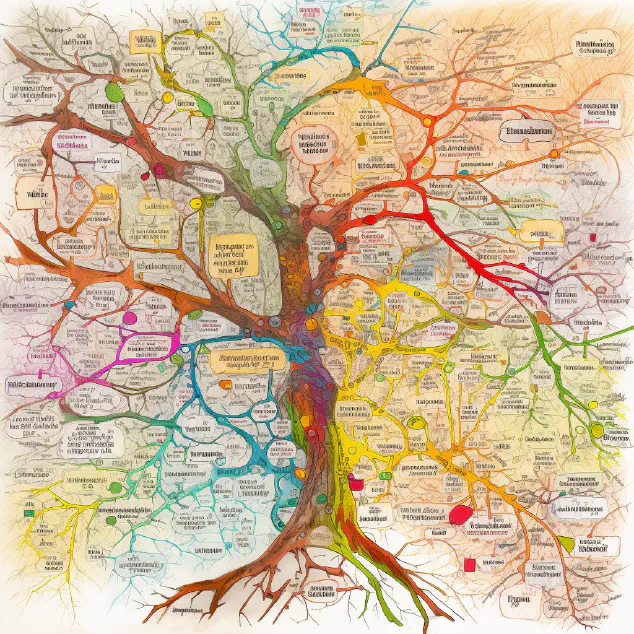
Mind Mapping for Students: Boosting Creativity and Productivity
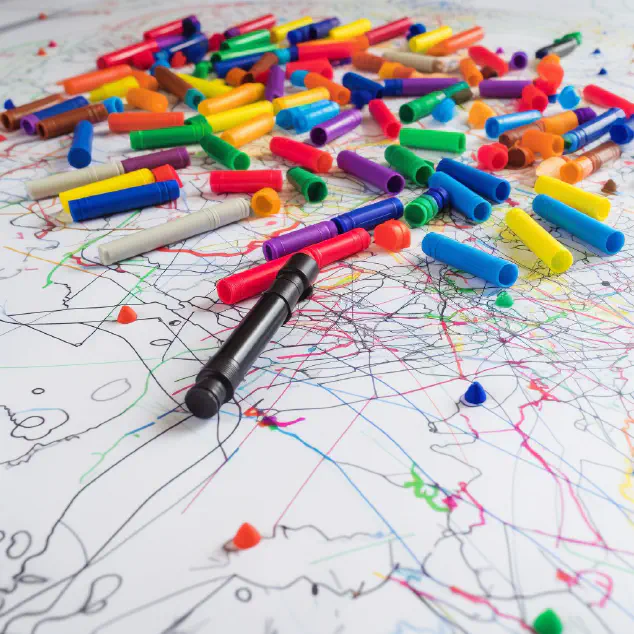
Unlocking Your Creative Mind: The Power of Mind Mapping
How to Use Mind Map In Writing – A Thorough Guide
This guide is brought to you by Zen Mind Map, the simplest mind map maker.
Before we can delve into using a mind map for writing, we must first understand what a mind map is. Apparently, there are many self-published authors who launch successful book releases by a creative writing exercise called mind mapping.
Mind mapping is one of many idea-generating strategies that rely on the association, which then comes out as a diagram with figures, facts, concept maps, phrases, keywords, etc. Overall, it is a powerful writing habit inspiration, especially for first-time authors.
There can never be two similar mind maps, even if you use the same mapping software . However, there are some arbitrary steps that you must follow for this approach:
- Choosing a central idea
- Creating ideas connecting to this subject
- Adding in colors / images to associate with these ideas
- Rearranging the map so that it doesn’t look confusing
- Reviewing and storing the map for a subsequent writing process
How To Use Mind Map For Writing Process?
Using a mind map to find your topic, choose the central idea .
Indeed, the very first thing to do is to decide on the backbone of your essay, which is the subject. The best approach is to pick a topic that allows you to provide new findings/conclusions.

The ideal topic should interest you, as it makes the process much less unbearable. At this stage, put something like “My Essay” in the center of your piece of paper.
Write Down Areas Of Interest (Potential Topics)
The next thing to do is surround the center with ideas, which is very easy if you have some mind mapping tools. They can range from suggestions from your professor, subjects discussed in class to anything relevant.
Subsequently, quickly start noting down some areas in which you find interesting - They can be anything, as it does not need to be related to the main topic at this step strictly. Remember to use mind map templates with a clear color scheme.
All you need to do is write down anything that pops up in your mind, preferably instinctively.
Review Their Relationships/Intersection
Now you have two sets of branches, one being the relevant ideas and the other being your personal interest. Find areas where these two sets intersect with each other.
This process results in a set of ideas that are both relevant to your goal and your interest.
Weigh Them Against Each Other With Pros And Cons
The next step is to weigh every idea in the set, analyzing each idea’s pros and cons.
Start The Elimination Process
Start the elimination process once you get the pros and cons of every single concept. Compare the list of advantages and disadvantages carefully, but mostly on the disadvantages.
Yet, remember that challenges are inevitable, but they should never hinder you from turning in your work.
Eliminate the choices until there is only one.
Using A Mind Map Standard To Compile Research Materials
Make a new branch for each source .
With this approach, the topic will be listed in the center of your map, and the child branches will be the secondary sources. From these branches, create smaller ones consisting of the secondary source’s topic, central idea, and quotes.
This method most benefits projects that do not require you to focus entirely on primary source material. Instead, find other similar types of writing and present the link between them to enforce your point.
Make A Branch For Each Area Of Your Topic
There are some involvements from the secondary sources, but they are not prominent.

Note everything you need onto the map while working through the source’s text. You need to work a lot more, but the payback will absolutely be worth it.
Using A Mind Map To Layout Your Outline
You will get a well-structured thesis outline out from the mind map. It allows you to generate a coherent structure consisting of examples, quotes, arguments, counter-arguments, etc., without losing grasp.
The visual representations of mind maps mean that you can quickly review your outline whenever you need to. All it takes is one look, and you can track your entire text structure from the thesis statement.
However, there certainly are some specific things that you need to pay attention to for a better creative process:
- Put a link between each topic with a corresponding research map created independently.
- Next, put in some notes or deadlines at each level, ensuring that the writing project is never behind schedule.
- Going over the deadline is always the clearest sign of bad writing.
- The last thing to do is export your finished mind map for easier access.
The Rules Of Mind Map For Writing Process
- The subject you want to discuss should always be at the center of the map.
- Branches should be going out, each representing one single idea relating to the subject.
- The last rule to keep in mind is the use of visuals such as images, icons, and color themes. They will serve as mental triggers, sparking more ideas within your brain to create a positive loop within your brain.
What Are The Benefits Of Mind Map For Writing?
- Newbie authors will have a complete overview of the entire topic and a clear flow of ideas.
- The second benefit of mind maps is that they let you see how the main topic connects with its supporting pieces. This results in an easier time planning resource materials and when to use them.
- Finally, this approach provides a much more enjoyable and attractive format to supply information to your brain. You will, in turn, remember the information more clearly, improving your writing potential.
Related Guides
Flowchart guides, brought to you by, zen flowchart.
ThinkWritten
How to Mind Map a Novel Plot
If the idea of a traditional outline seems intimidating, a mind map might just be the right solution for you. Mind Maps are great for brainstorming ideas, keeping organized, and can help you make progress in writing your book.

We may receive a commission when you make a purchase from one of our links for products and services we recommend. As an Amazon Associate we earn from qualifying purchases. Thank you for support!
Sharing is caring!
If the idea of a traditional outline seems intimidating, creating a mind map for writing your novel might just be the right solution for you. In this post we’ll share the basic process of how to mind map a novel plot, as well as some tips to make it an effective plotting strategy that works for you.
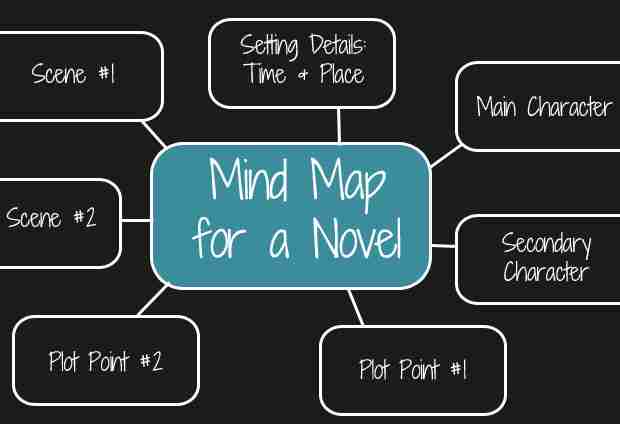
What is a Mind Map and Why Should I Use One to Plot My Novel?
A mind map is a visual representation of ideas and how they all relate to one another. Mind maps are great for brainstorming ideas, keeping organized, and can help you make progress in writing your book.
While there are no set rules for what your mind map should look like, they generally do follow some basic similarities. Typically, a mind map is created on either a blank sheet of paper or on a blank screen if you are using a mind map software tool such as Scapple.
The mind map begins with a central topic in the middle, and then new ideas can be added, moved and connected to different ideas as you begin to brainstorm and think of different story lines.
Novel Plotting Mind Map Examples
One of the easiest ways to understand how to mind map your novel is to look at a few examples. With just a few different examples, you can easily see the many different ways a mind map can help you in brainstorming for ideas and organizing the flow of ideas!
Note: If you like these mind maps shown below, each of these mind map examples we use below were used with the software program Scapple from Literature & Latte – the same company which gives us every writer’s favorite software Scrivener. It’s one of my favorite writing tools!
Mind Map Novel Example #1: Little Red Riding Hood
In this example mindmap, we are looking at the familiar tale of Little Red Riding Hood. While the original story of course is not a novel with chapters, the storyline and plot is familiar enough that it will help you identify some of the different aspects of how we went about organizing the ideas in a mind map.
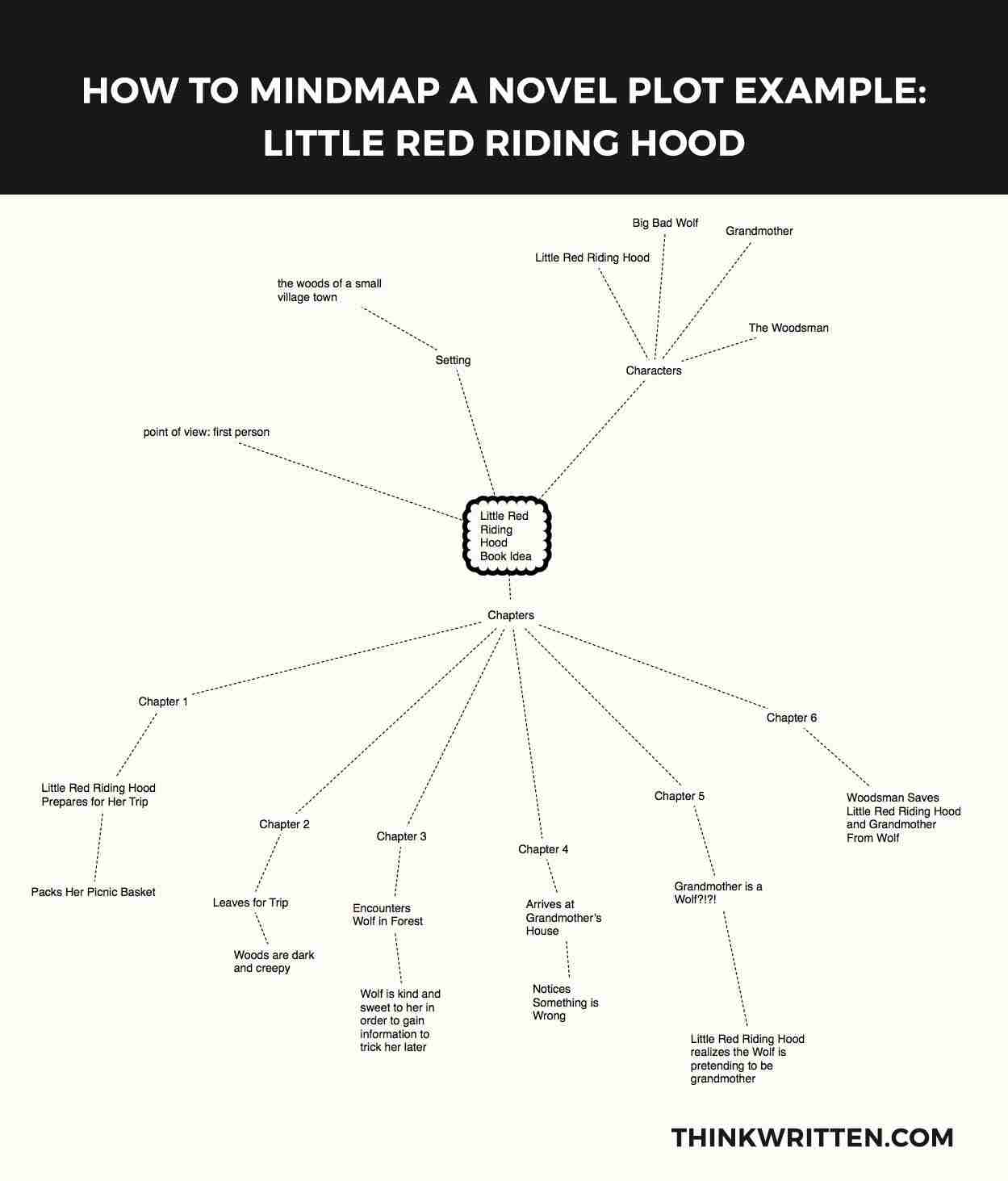
This first example of Little Red Riding Hood is a very structured method of mind mapping your novel. It lists the characters, the setting, the point of view, and a rough outline of the 6 main scenes/chapters I would include if I were writing this story as a book.
Using a mind map in this way is a great method to use when you already have a good understanding of your plot, characters, and the different scenes that will happen in your novel. Being able to move your different notes and connect them as needed gives you a lot of flexibility!
Mind Map Example #2: Half Baked Book: When You’re Not Sure What Your Book is About Yet
With our first example, we know the story of Little Red Riding Hood well and have a very good idea of how the story would unfold. We knew the characters well enough in advance that I did not write out a lot of the details.
However, when you are starting with your very own novel and characters you created out of your imagination, it is helpful to just brainstorm every possible idea you have first – especially in the case of a “Half Baked Book” – when you have a seed of an idea, but don’t actually have a fully developed plot yet.
Using a mind map is a great way to get some ideas for who your main characters will be and what events will unfold. Once you get all of your ideas down, you can go back to clean up and organize the sequence of events and decide which ideas are worth keeping – and then of course move onto actually writing!
Here’s my initial brainstorm for a “half baked” book idea:
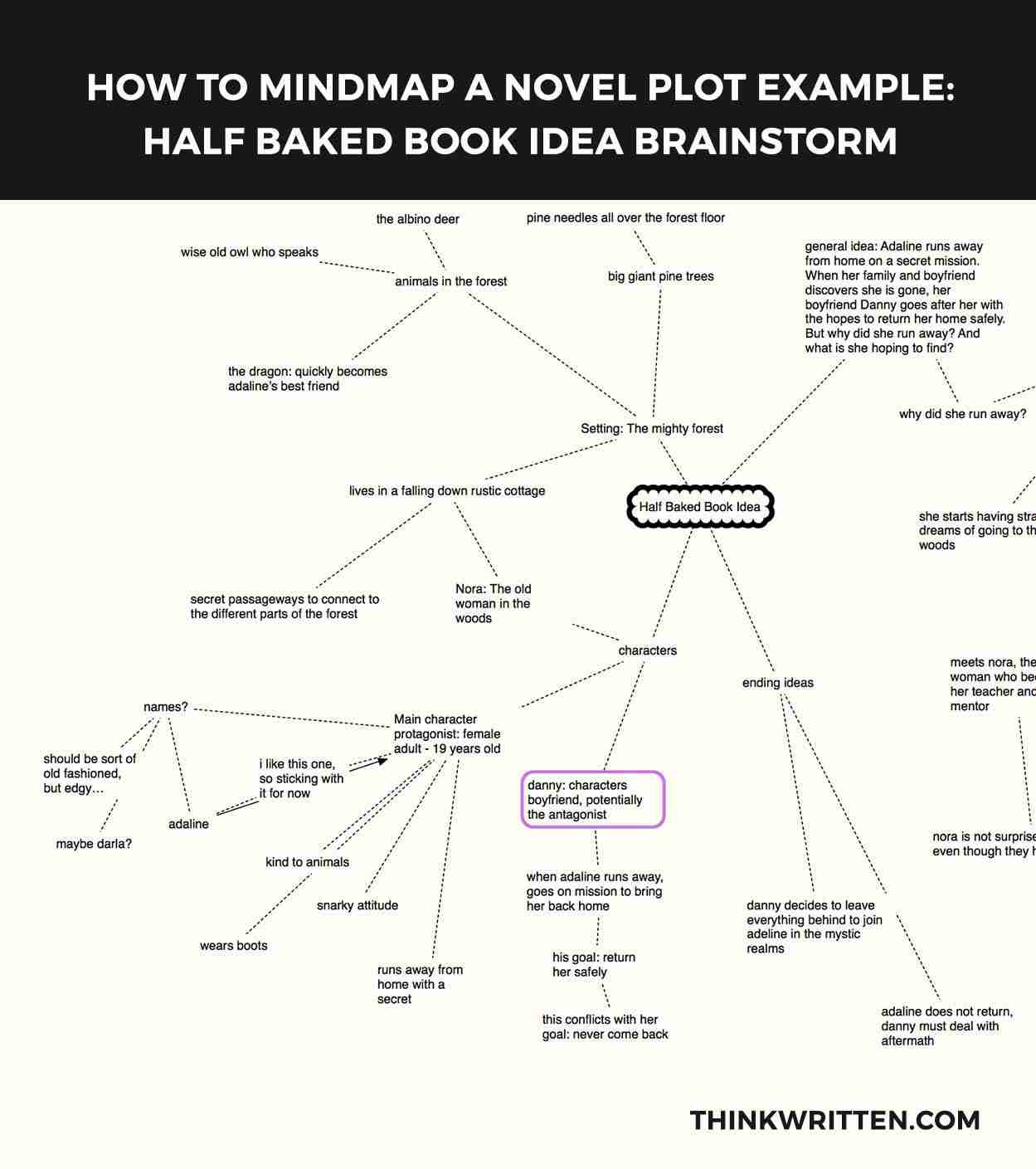
I started this mind map above by simply trying to figure out who my characters would be and what the setting would be. Then I thought of what was happening in this story – why is this story happening in the woods, and why are the characters there in the first place?
Before long, within about 10 minutes I had a whole idea for a novel!
While it’s not exactly a novel I think I am going to write anytime soon, it certainly was a fun creative exercise to challenge myself to come up with a novel plot like that on the fly using a mind map!
How to Mind Map Your Novel
Now that I’ve given you a couple of examples, learning how to mind map your novel is pretty simple. There are no straightforward “rules” about the wrong or right way to do this – and since it is entirely a fun creative writing exercise, you should absolutely have fun with it and go with whatever flows and works for you!
Here are the main steps to create your mind map:
Step 1: Choose Paper or Digital:
The two most common and easy ways to create a mind map is to either create it on actual physical paper, or to use mind mapping software like Scapple, which is what I use in the mindmap diagrams above.
There are benefits of choosing paper – you can draw, doodle, highlight, add color, add illustrations, etc. You are not limited to using just words and lines!
However, there are also benefits to using a mind mapping software such as Scapple. My favorite part about Scapple is that you can export your mind map data into an outline of all of your notes. This makes it super easy to move onto the outline process if you enjoy writing from a basic novel outline.
Once you have your format chosen, you are ready to get started!
Step #2: Start with a central topic in the middle of the page.
It helps to begin with creating a central topic in the center. This would generally be the working title of your story, or a summary of what the book would be about. For example, “Little Red Riding Hood” would work as a title for that if you were to mind map the entire story of Little Red Riding Hood.
Step #3: Create Sub-Topics:
The next step is to start creating sub-topics. You can organize sub-topics any way that works best for you.
For example, you may have a sub-topic for characters, and then a sub-topic for each character, and go even further with sub-topics for describing your character’s personality and traits.
In my half-baked novel mind map example above, you can see I even left notes that I wasn’t sure what to name my main character!
You can then do the same thing for plot, setting, themes, and any miscellaneous ideas you might have during the process.
There are no rules, so just keep going. One of the advantages to using a digital software program for mind mapping? You won’t run out of paper or space to keep those ideas flowing! You can also very easily move and re-arrange items, giving you a lot of flexibility during your creative writing brainstorm process.
6 Tips for Working With Mind Maps for Writing a Novel
Tip #1. use colors.

Making your mind map colorful will keep it more exciting and interesting. You can use any color scheme you’d like. Most mind map software programs will allow you to customize the colors of lines and borders.
Using different colors can be helpful for organizing different thoughts and sections of the mind map – for example, you could use the color red to link together common themes or ideas, or the color blue to signify a specific character.
If working on paper, pull out those colored pencils and pens! Not only does this make it more exciting, but it helps exercise the creative side of your brain to get the ideas flowing freely.
Tip #2: Add Images if Desired

While Scapple does not have a way to insert images that I am aware of, there are many other online mind mapping software programs that will allow you to insert images. You can also always doodle some of your own pictures if working on paper.
Tip # 3. You Get to Determine How Detailed it Needs to Be :
Some people suggest only writing a few words per line, while others may write full blown characterization summaries. It’s entirely up to you how much information your mind map contains!
If it seems overwhelming at first, short sentences and phrases are really all you need to get started. Don’t worry if you don’t have a whole lot of details just yet, especially if you are working with the “half baked novel” seed of an idea and don’t have a fully developed plot or list of characters yet.
If you’re not sure of all the details yet about who your main characters will be, using character development questions can be a helpful starting place. You will also probably feel A LOT better about the process if you read our other article on novel planning: How to Avoid Over Planning Your Novel .
Tip # 4. Remember Practice Makes Perfect :
Just like any new skill, practice will help you become better at making mind maps. Try to make it a regular practice for anytime you get an idea for a story idea.
Making a mind map is a great creative writing exercise to help your mind flow and relax to open up to new ideas and thoughts.
Up for a creative challenge to make more mind maps and incorporate them into your writing practice? Try creating a mind map from one of our creative writing prompts we feature on our website!
Tip #5. Try Both Digital and Paper Types of Mind Maps :
Some people prefer making them on the computer, while others enjoy drawing and coloring them out. Try them both to see what you like best.
Sometimes, I might even start one on the computer and then create another version of the same mind map on paper, because it really does seem to make a difference when your brain is stimulated while you are holding an actual pen or pencil in your hand!
If making on paper, using colored pencils or pens can really help stimulate the creative side of your brain.
You can also always possibly create a digital version of your mind map using a program like Scapple which will make for a very quick easy export to outline format when you go to actually sit down and start outlining and writing that novel!
Tip #6. Think of it as a Free Write:
Mind mapping needs no planning or special skills. Don’t dismiss any ideas you think of while creating your mind map and make a place for it on the map. Try to work quickly, as this will help with making associations.
Sometimes it can be helpful to set a timer, as this will ensure you don’t spend too much time thinking about it. The less thought you put into it and the more you treat it as a method of quickly capturing flowing ideas however the associations may come out of your brain – the more creative and beneficial your results can be!
Learning to mind map for novel planning, plotting, and character development can be a LOT of fun as a writer – and it can be a useful skill for many other types of writing as well. You can use this same process for memoirs, non-fiction books, and more!
Have any other tips for how to mind map a novel? Have you used the mind mapping process to brainstorm your book ideas or to plot a novel? We’d love to hear your experiences: Share your thoughts in the comments section below!
Chelle Stein wrote her first embarrassingly bad novel at the age of 14 and hasn't stopped writing since. As the founder of ThinkWritten, she enjoys encouraging writers and creatives of all types.
Similar Posts

The Hero’s Journey: A 17 Step Story Structure Beat Sheet

How to Write a Novel: Writing a Book in 4 Steps

What is an Antagonist?

How to Write a Bestseller Novel: 12 Tips

How to Avoid Over Planning Your Novel

What is a Protagonist?
17 comments.
Excellent article! I recently bought a book on plotting called “Pen the Sword: the universal plot skeleton of every story ever told” by Adron J. Smitley. It’s improved my writing dramatically. Walks you through the entire process of plotting your novel from beginning to end through such easy steps anyone can use it to write a novel. I highly recommend Pen the Sword to any writer!
Thanks Marsha, we’ll have to check that one out!
Good read! I will definitely try mind mapping, it seems to be a great way to expand on half baked ideas. Just one thing about the images in Scapple: I had a look at it and found that inserting an image is as easy as dragging it from the explorer to the Scapple canvas. So don’t discard Scapple for that reason! 🙂
Good to know! Mind mapping definitely helps organize those ideas that are all over the place!
This was so helpful! I have been struggling to find a way to orient myself and my main character to my story. This helped so much. Thank you!
Glad it was helpful for you Amethyst! I love mind maps, it really helps to visualize where the story might go!
I really hope you add language Arabic
Hi Jafar, I am not fluent in Arabic, but if you have any suggestions on translating I’m happy to hear them!
These are truly great! It reminds me of the first mind mapping tool I used, GitMind.
All of your articles are amazing. Those are really helpful. Thank you so much for writing them. I started writing recently. I will follow your instructions as I found they are a really good way to write a novel.
Thank you, i think this is so important. I will make the mind map now, bcz now im inspire to make this mind map ^^ thx!!
Hi thank this is a great idea everyone in my family is doing it thank u again.
Thank you so much ma’am… amazing article…
Excellent piece! With short stories, I’ve always started (after having the germ of an idea) with handwritten notes, then written by the seat of my pants. Works fine, and I’ve sold a couple dozen stories.
But now I’m attempting longer, more complex pieces, and need a way to keep track of all the elements. Read a book about outlining, but most of it was the author lecturing me on what makes up a story and how to create an antagonist, etc. That, I don’t need instruction in. Just needed a little organization for when my mental whiteboard gets to complicated. What you’ve shown here looks what I need.
I’m glad you found it helpful! 🙂
I really love this Idea. I am going to try this.
Glad it inspired you Lisa!
Leave a Reply Cancel reply
Your email address will not be published. Required fields are marked *
Save my name, email, and website in this browser for the next time I comment.
- Features for Creative Writers
- Features for Work
- Features for Higher Education
- Features for Teachers
- Features for Non-Native Speakers
- Learn Blog Grammar Guide Community Events FAQ
- Grammar Guide
How Mind Mapping Can Aid Creativity in Your Writing Process

The writing process isn’t always a smooth road. Like any good story, it often contains a few twists and turns.
Writer’s block is a common antagonist for many writers, shielding you from your creative potential as it forms a mental barrier in your mind – one that can sometimes feel impossible to break down. Thankfully, mind mapping is there to help.
Mind mapping is a versatile technique that can help you not only overcome writer’s block, but aid creativity within your writing process. So, no matter how you choose to tackle your work, you can take away the stress and focus on the important part – the words.
What Is Mind Mapping?
How can mind mapping benefit my writing process, tapping into our childlike creativity, overcoming writer’s block, giving yourself a break, get a second opinion.
Sometimes referred to as a spider diagram, a mind map is a visual thinking tool used to capture ideas and information. Mind maps utilize a unique combination of keywords, images, and visual-spatial awareness to enhance your brain’s creative thinking power. Simply put, mind maps allow you to take the interconnected trains of thought in your brain and capture them in one place.
Proven to boost memory, creativity, and productivity, mind maps reflect our natural thinking processes by using radiating branches that are designed to encourage our brains to make associations between ideas and explore our unrestricted imaginations. When you stop to think about how your brain works, you probably find that one idea sparks another, until you have a whole web of interconnected thoughts in your head. Mind maps work by capturing this process, ensuring nothing gets forgotten.
No matter what you are working on, writing requires a great deal of creativity and imagination to bring your ideas to a colorful reality on the page. As our most dominant sense, our visual experience is the main way that we make sense of the world – so it’s only natural to use a visual thinking tool to explore our ideas.
Mind maps are great for building the bigger picture, so try using one to outline the structure of your next book, feature article, or blog post. Use the main branches of your mind map to identify the different areas of your content, then expand on each area further. This provides a useful way to develop and organize your ideas and clearly see the areas you need to develop. By piecing together related elements of your writing in this way, you will be able to draw connections between them, improving the flow of your ideas. Mind maps will give you the confidence in knowing that all of your ideas are stored in one place, where you can easily get a bird’s-eye view of your writing project as a whole.
When getting started with a mind map, pair images with words where possible. Using visual stimuli will help to aid your cortical skills while keeping your creative juices flowing. Our brains process visual information 60,000 times faster than text, so they can help you to quickly and easily draw associations between your branches and generate new ideas.
As a writer, you know the power of creativity can help launch a piece of writing to the next level. But sometimes, even the best writers need a tool to help them uncover the great ideas locked inside their heads.
When we think about imagination, the perceptibility of children is something to behold. Kids’ imaginations are never-ending sources of creativity and inspiration, as they begin to explore and question the world around them. However, as we grow up, our life experiences begin to shape the way we view and tackle challenges. As a result, we naturally start to build up barriers in our mind around what we think is achievable.
When using a mind map during your creative brainstorming sessions, try to remove any mental barriers and capture every idea that comes into your head. There will be plenty of time to organize these later and eliminate any ideas that don’t work. By allowing your mind to capture every thought (no matter how "out there" it may seem), you can clearly see where different sparks of inspiration have originated from. Make an effort to challenge your thinking processes, so you can unlock your ability to come up with unique and creative ideas and solutions.
When your inspiration is on a roll, you’re likely to have ideas pouring in from every angle. Using a mind map means that no idea is left uncaptured – so, unlike the way a vivid dream can soon become a hazy memory, your sparks of inspiration won’t evaporate into your subconscious.
Writer’s block can feel like an impossible wall to pass through. Trying to force ideas to come when you’re experiencing writer’s block can easily result in stress and spending wasted minutes writing and deleting sentences in frustration. Thankfully, there are lots of handy ways to help improve your focus as a writer . When you’re struggling to put your ideas into words, capturing them in a mind map means you can think about the bigger picture, rather than forcing yourself to construct the perfect sentence structure. This will help to broaden your thinking and engage your mind in limitless possibilities, rather than focusing on the finer details at this stage.
As mind maps typically use one keyword per branch, this allows you to draw greater connections from each thought, helping to focus your mind on the most important aspects of the problem you’re facing. Making use of colors and images will also help to stimulate your creativity and imagination when you feel like you’ve hit a creative brick wall.
We all know that creative ideas can’t be forced. It’s important to listen when you feel like your body is telling you to take a step back. Fortunately, mind mapping is a great way to give yourself a break and engage your mind in a focused daydream. A focused daydream is the process of taking a step back from your research topic to switch off. During this time, your unconscious mind will incubate the knowledge you have gathered, allowing innovative solutions to float to the surface of your mind when you come back to tackle your work.
Try mind mapping in a different environment to where you typically do your writing. Stepping away from your desk and heading out to the garden, or to your local coffee shop, will help to give your mind a fresh perspective to tackle your challenge from a different angle. Once you have your mind map filled with all your thoughts, you can then come back to this for reference when you feel your writer’s block beginning to lift.
Whether you’re a solo author, a feature writer, or you work within a content team, we all know the phrase "two heads are better than one." So, be sure to harness the creative brainpower of those around you. While it’s important to hone in and focus on your writing individually, the power of teamwork goes a long way when developing your ideas. Utilizing the power of mind mapping software, you can easily share your mind maps with friends and colleagues so they can contribute suggestions, building on your ideas while keeping them stored safely in one, collaborative space.
With all the technological advancements in our midst, mind mapping has stood the test of time. Combining this traditional method of note-taking and integrating it with the digital tools we use every day, it enables us to further enhance our daily creativity and thinking processes. As writers, we often have to maintain a weighted balance between our creativity and the organisation of our workload. Mind mapping is a powerful and adaptable technique to help writers capture and explore their creative ideas, then put structure behind these to get their writing off to a flying start.

Be confident about grammar
Check every email, essay, or story for grammar mistakes. Fix them before you press send.
Ayoa is a work management tool that combines Mind Mapping and Task Management features, enabling writers to generate and capture their ideas, then turn these into tasks that they can track and manage from start to finish. Ideal for writers looking to stay on top of projects and deadlines, for a smoother and more productive writing process.
Get started with ProWritingAid
Drop us a line or let's stay in touch via :

- Mind Map Maker
- Concept Map Maker
- Bubble Map Maker
- Brace Map Maker
- Sunburst Chart Maker
- Online AI Note Taker
- Timeline Maker
- Tree Diagram Maker
- Fishbone Diagram Maker
- Organizational Chart Maker
- Gantt Chart Maker
- Spider Diagram Maker
- EdrawMind AI
- AI Summarize
- AI Mind map
- AI Article generation
- AI Copywriting
- AI Translation
- --> --> >--> -->